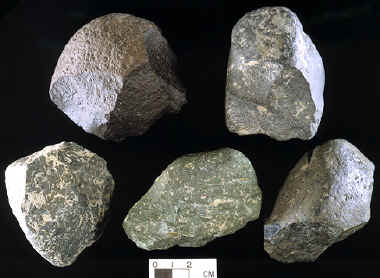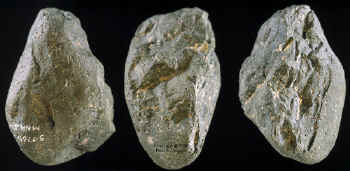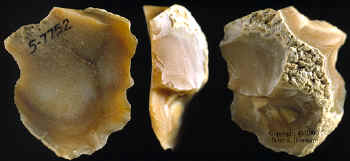THE OLDOWAN STONE TOOL
INDUSTRY
1.5
to 2 MILLION PLUS
YEARS AGO
The oldest formally recognized stone tool assemblage in the world is
Oldowan. This tradition of making simple flakes struck off unmodified
cores began during the Lower Paleolithic period in Africa. The Oldowan
stone tool industry was first defined from examples excavated from bed I
and bed II at Olduvai Gorge in Tanzania. Paleoanthropologist refer to Homo
habilis as the maker of these tools because they appear in the fossil
record about the same time or a little later than the earliest Oldowan
tools. But there were also several other hominid species living at the
same time on Oldowan sites in Africa. So it's a complicated issue as to
which one or ones were making the tools.

OLDOWAN CHOPPER
CORES
OLDUVAI GORGE,
TANZANIA AFRICA
UNIVERSITY
OF CALIFORNIA--BERKELEY AND CRAFT RESEARCH CENTER COLLECTIONS
Chopper Cores are among the most common forms of stone tools found on the
earliest Stone Age sites in Africa. A large percentage of them are thought
to have been made by Homo habilis nearly 1.9 million years ago. They also
represent the simplest of stone tool technologies. Some may have been used
for food processing operations that involved pounding, breaking or
bashing. Other so called Choppers may only have been cores from which
flakes were removed that were used for cutting or scraping. Some Oldowan
Choppers may have been used for both purposes.

CLICK ON PICTURE FOR
VERY LARGE TRIPLE IMAGE
OLDOWAN CHOPPER
CORE
OLDUVAI GORGE,
TANZANIA AFRICA
UNIVERSITY
OF CALIFORNIA--BERKELEY, DEPT. OF ANTHROPOLOGY COLLECTION
This
Chopper Core was found in Bed II at Olduvai Gorge in northern Tanzania.
It's thought to have been made by homo habilis nearly 1.9 million years
ago.

CLICK ON PICTURE FOR
VERY LARGE TRIPLE IMAGE
OLDOWAN FLAKE
TOOL
OLDUVAI GORGE,
TANZANIA AFRICA
UNIVERSITY
OF CALIFORNIA--BERKELEY, DEPT. OF ANTHROPOLOGY COLLECTION
This unmodified flake represents one of the most important stone tool
types made by Homo habilis 1.5 to 2 million years ago. The first
deliberately manufactured stone tools were simple flakes struck off an
unmodified core. This example is made of chert. Most stone tools from the
Lower Paleolithic Oldowan industry at Olduvai Gorge were made from the
more common basalt. Basalt is a coarser stone that doesn't allow for
reliable edge wear analysis like the denser chert with a higher silica
content. Edge wear analysis with the use of a scanning electron microscope
allows archaeologists to determine in some ways what types of materials
the edges of the stone tool was cutting.
|